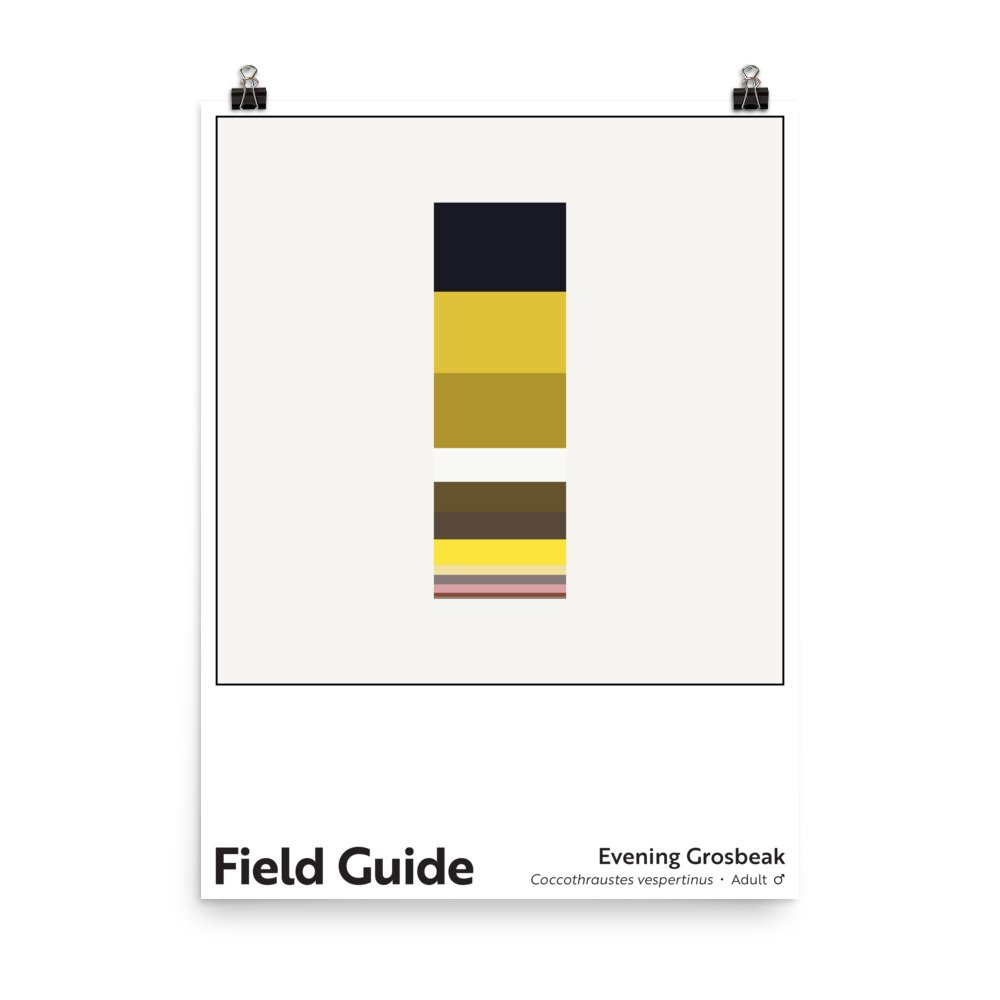 Image 1 of 2
Image 1 of 2

 Image 2 of 2
Image 2 of 2



Field Guide : Evening Grosbeak (Male)
Unlimited edition. 18 x 24 inch, museum-quality poster on matte paper.
The evening grosbeak’s scientific binomial, Coccothraustes vespertinus, translates as “twilight seed breaker.” That’s beautifully badass, but only the “seed breaking” portion accurately describes the species’ habits. So how did this handsome, gold-and-mustard bird come to be mistakenly associated with evening or twilight? Early 19th century bird collectors only heard or saw the bird at dusk, and their reports led ornithologists to erroneously assume the species only sings in the evening. In fact, the species doesn’t sing much no matter the time of day, but taxonomists, not yet realizing this, dubbed it Fringilla vespertina, or “twilight finch.”
The taxonomy has been tinkered with since then, and the reassignment to the genus Coccothraustes occurred only within the last forty years. The move still isn’t universally accepted, but genetic analysis and etymology both suggest it’s the best fit. With its heavy bill, “seed breaking” is exactly what this stocky finch does, especially during the winter, when seeds make up the bulk of their diet. They’re so good at opening seeds large and small that other bird species with smaller beaks (like redpolls and pine siskins) will follow grosbeaks to glean seed scraps the larger, more adept birds leave behind.
Despite their seed-opening proficiency, the evening grosbeak population is dwindling; since the mid-20th century, it’s estimated the species has experienced a 92% decline. Although it’s considered a threatened species today, conservation is challenging because the reasons for the grosbeak’s struggles aren’t exactly clear. Habitat modification is a contributing factor, but the specifics of what and where aren’t known. Additionally, evening grosbeaks are the 10th-most frequently reported species killed by collision with building windows. Ornithologists also cite disease and a reduction in food sources as the climate changes.
Note: These archival poster prints feature rich, appealing colors. I encourage customers to take care in handling them until they are framed/protected for display; the darker colors on the matte paper can be scratched. They ship rolled, so customers need to flatten them before framing (or have their framer do so).
Charitable Sales Model: Whenever one of these poster prints is purchased, a charitable contribution equal to 10% of the print’s cost (or $3.60) is made to a nonprofit working to tackle environmental or social challenges. Read more about my charitable sales model here.
Unlimited edition. 18 x 24 inch, museum-quality poster on matte paper.
The evening grosbeak’s scientific binomial, Coccothraustes vespertinus, translates as “twilight seed breaker.” That’s beautifully badass, but only the “seed breaking” portion accurately describes the species’ habits. So how did this handsome, gold-and-mustard bird come to be mistakenly associated with evening or twilight? Early 19th century bird collectors only heard or saw the bird at dusk, and their reports led ornithologists to erroneously assume the species only sings in the evening. In fact, the species doesn’t sing much no matter the time of day, but taxonomists, not yet realizing this, dubbed it Fringilla vespertina, or “twilight finch.”
The taxonomy has been tinkered with since then, and the reassignment to the genus Coccothraustes occurred only within the last forty years. The move still isn’t universally accepted, but genetic analysis and etymology both suggest it’s the best fit. With its heavy bill, “seed breaking” is exactly what this stocky finch does, especially during the winter, when seeds make up the bulk of their diet. They’re so good at opening seeds large and small that other bird species with smaller beaks (like redpolls and pine siskins) will follow grosbeaks to glean seed scraps the larger, more adept birds leave behind.
Despite their seed-opening proficiency, the evening grosbeak population is dwindling; since the mid-20th century, it’s estimated the species has experienced a 92% decline. Although it’s considered a threatened species today, conservation is challenging because the reasons for the grosbeak’s struggles aren’t exactly clear. Habitat modification is a contributing factor, but the specifics of what and where aren’t known. Additionally, evening grosbeaks are the 10th-most frequently reported species killed by collision with building windows. Ornithologists also cite disease and a reduction in food sources as the climate changes.
Note: These archival poster prints feature rich, appealing colors. I encourage customers to take care in handling them until they are framed/protected for display; the darker colors on the matte paper can be scratched. They ship rolled, so customers need to flatten them before framing (or have their framer do so).
Charitable Sales Model: Whenever one of these poster prints is purchased, a charitable contribution equal to 10% of the print’s cost (or $3.60) is made to a nonprofit working to tackle environmental or social challenges. Read more about my charitable sales model here.